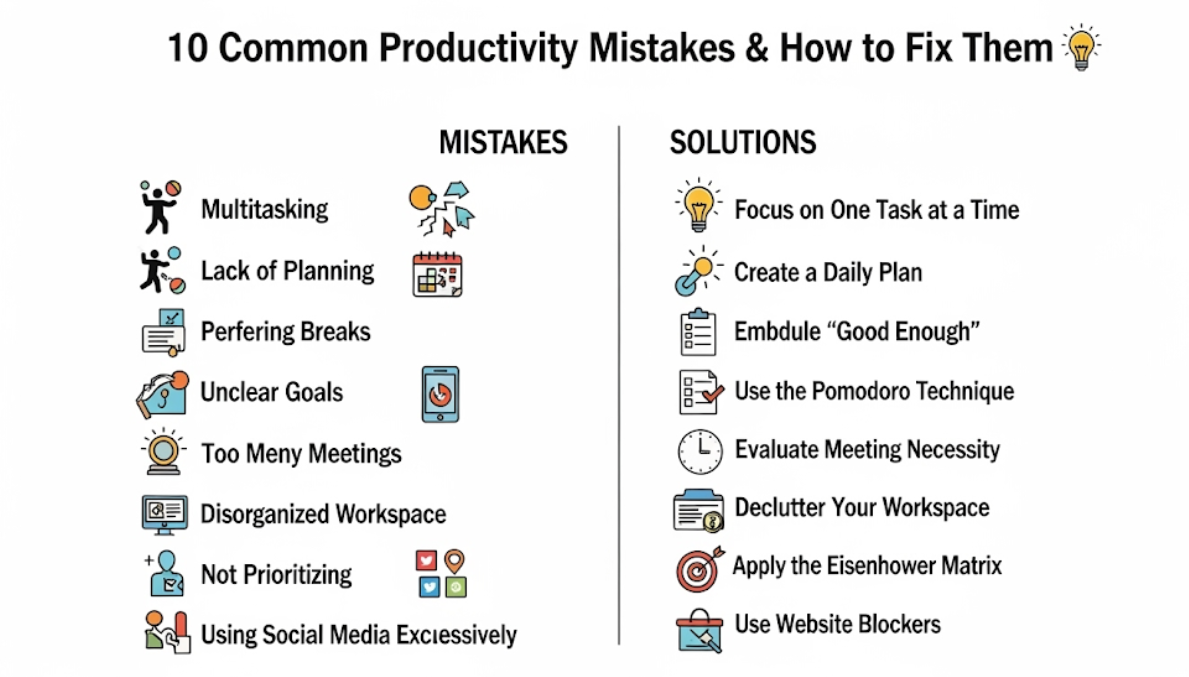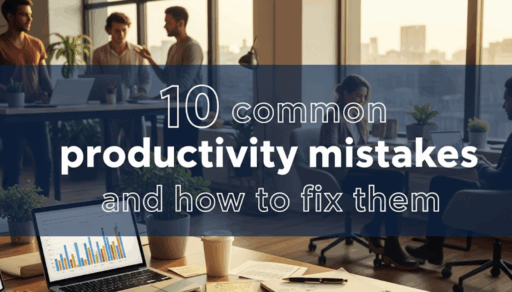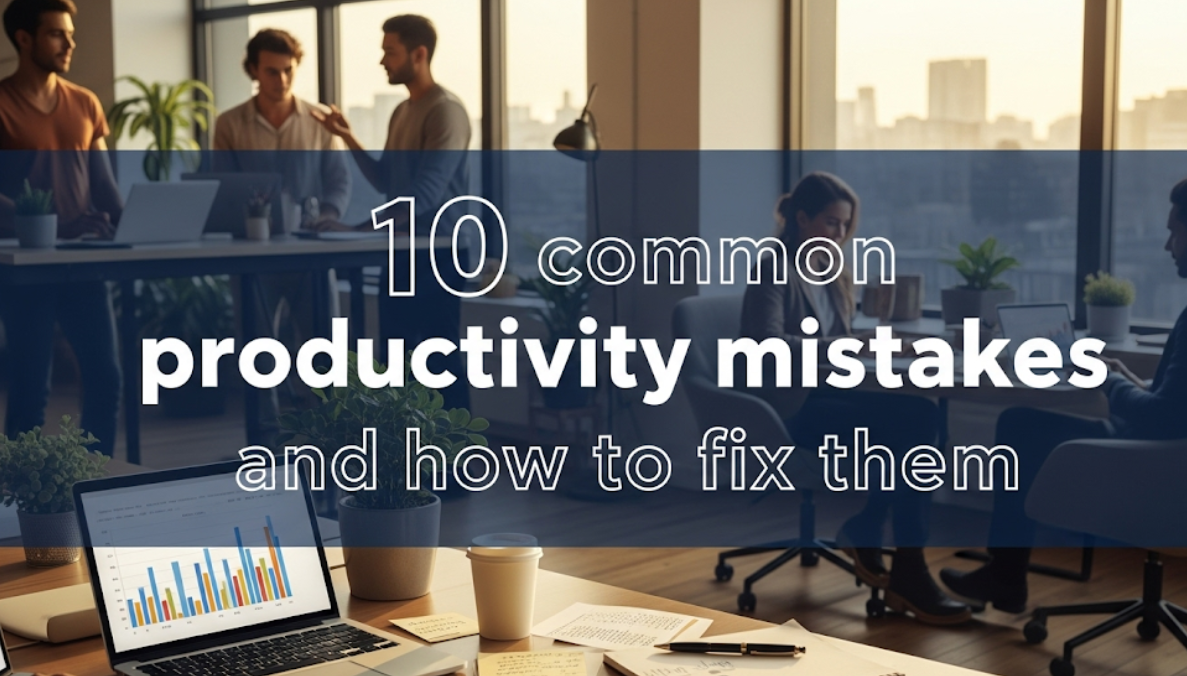10 Common Productivity Mistakes and How to Fix Them
Getting things done shouldn’t feel like climbing Mount Everest every single day. Yet millions of people struggle with productivity, often making the same mistakes that keep them spinning their wheels instead of moving forward.
If you’ve ever felt overwhelmed by your to-do list, constantly behind schedule, or frustrated that others seem to accomplish twice as much in the same amount of time, you’re not alone. The good news? Most productivity problems stem from common mistakes that are surprisingly easy to fix once you know what to look for.
This guide reveals the ten most frequent productivity traps people fall into and provides practical solutions you can start using today. Whether you’re a student juggling assignments, a professional managing multiple projects, or someone trying to balance work and personal life, these insights will help you work smarter, not harder.
1. The Multitasking Trap: Why Doing Everything at Once Gets Nothing Done
Many people believe multitasking makes them more productive. They answer emails while on conference calls, scroll through social media during study sessions, or try to cook dinner while helping kids with homework. This approach feels efficient, but research shows it’s actually killing your productivity.
The Real Cost of Task Switching
When you switch between tasks, your brain needs time to refocus. Scientists call this “switching cost,” and it can reduce your efficiency by up to 40%. Imagine losing nearly half your productive time just because you’re jumping between activities.
Here’s what happens in your brain during multitasking:
- Your prefrontal cortex works overtime to manage different tasks
- Each switch requires mental energy to reorient your attention
- You make more mistakes and miss important details
- Simple tasks take longer to complete
How to Fix It: Master Single-Tasking
The solution is single-tasking – focusing on one thing at a time until completion or a natural stopping point.
Practical Steps:
- Close unnecessary tabs and apps when working on important tasks
- Use the “one-tab rule” – keep only the tab you’re currently using open
- Set specific times for checking emails and messages (like 10 AM, 2 PM, and 5 PM)
- Create physical barriers – put your phone in another room during focused work
- Practice the 25-minute rule – work on one task for 25 minutes without interruption
| Task Type | Single-Tasking Approach | Time Saved |
|---|---|---|
| Writing emails | Close all other apps, respond to emails only | 30-40% |
| Studying | One subject, one location, no distractions | 25-35% |
| Creative work | Dedicated workspace, specific time blocks | 40-50% |
2. Perfectionism Paralysis: When Good Enough Becomes Your Enemy
Perfectionism might seem like a positive trait, but it often becomes a productivity killer. Perfectionists spend excessive time on minor details, struggle to start projects, and rarely finish anything because nothing ever feels “good enough.”
Signs You’re Stuck in Perfectionism
- Spending hours on tasks that should take minutes
- Avoiding starting projects because you don’t have the “perfect” plan
- Redoing completed work multiple times
- Missing deadlines because you’re still “improving” your work
- Feeling stressed about tiny imperfections others won’t notice
The 80/20 Solution: Good Enough Gets Things Done
The Pareto Principle states that 80% of results come from 20% of efforts. This means you can often achieve most of your goals without perfect execution.
Action Plan:
- Set “good enough” standards for different types of tasks
- Use time limits – give yourself a specific amount of time to complete something
- Ship it anyway – submit work when it meets minimum requirements, even if you see room for improvement
- Focus on impact – ask “Will anyone notice this improvement?” before spending extra time
- Celebrate completion over perfection
Time Allocation Framework:
- High-stakes projects: 100% effort, take the time needed
- Important but routine tasks: 80% effort, set time limits
- Low-stakes activities: 60% effort, aim for completion
- Practice or learning tasks: 50% effort, focus on progress over polish
3. Planning Pitfalls: Why Your Schedule Never Works
Poor planning is like trying to navigate a new city without a map. You’ll eventually get somewhere, but it won’t be efficient, and you’ll probably end up lost and frustrated.
Common Planning Mistakes
Most people make these critical planning errors:
- Overestimating available time and underestimating task duration
- Not accounting for interruptions and unexpected events
- Creating rigid schedules that fall apart with one small change
- Planning tasks but not energy levels throughout the day
- Ignoring buffer time between activities
Smart Planning Strategies That Actually Work
Effective planning requires both structure and flexibility. Here’s how to create plans that survive real life:
The 3-2-1 Planning Method:
- 3 big tasks per day (important work that moves you forward)
- 2 medium tasks per day (necessary but not urgent)
- 1 small task per day (quick wins that boost motivation)
Energy-Based Scheduling:
- Identify your peak energy times (most people have 2-3 high-energy periods daily)
- Schedule demanding tasks during peak energy
- Handle routine tasks during lower energy periods
- Plan breaks before energy crashes
Buffer Time Formula:
- Add 25% extra time to all task estimates
- Include 15-minute buffers between meetings
- Reserve 1 hour daily for unexpected issues
- Keep Friday afternoons flexible for catch-up
| Planning Mistake | Better Approach | Expected Outcome |
|---|---|---|
| Back-to-back meetings | 15-minute buffers between meetings | Less stress, better preparation |
| Exact time estimates | Add 25% buffer to estimates | More realistic expectations |
| Same intensity all day | Match tasks to energy levels | Higher quality work |
4. Distraction Disasters: How Interruptions Steal Your Day
The average person gets interrupted every 11 minutes and takes 23 minutes to fully refocus. This means most people never achieve deep focus during their workday.
The Hidden Cost of Interruptions
Interruptions don’t just steal the time they take – they steal the time before and after as you transition between tasks.
Interruption Impact Chart:
- 1-minute interruption = 5-10 minutes of lost productivity
- 5-minute interruption = 15-25 minutes of lost productivity
- 15-minute interruption = 30-45 minutes of lost productivity
Building Your Distraction Defense System
Environmental Controls:
- Create a dedicated workspace free from non-work items
- Use noise-canceling headphones or background noise apps
- Position your screen away from high-traffic areas
- Remove visual distractions like unnecessary decorations or clutter
Digital Boundaries:
- Turn off non-essential notifications on all devices
- Use “Do Not Disturb” modes during focused work sessions
- Install website blockers for social media and news sites during work hours
- Keep your phone in a drawer or another room
- Use airplane mode when deep focus is critical
Social Boundaries:
- Communicate your focused work hours to family and colleagues
- Use visual signals like closed doors or headphones
- Schedule specific times for conversations and questions
- Learn to say “Can we discuss this at 3 PM?” instead of stopping everything
5. Energy Management Gone Wrong: Running on Empty
Time management gets lots of attention, but energy management is often more important. You can have all the time in the world, but if you’re exhausted, you won’t get much done.
The Four Types of Energy
Physical Energy:
- Sleep quality and quantity
- Nutrition and hydration
- Exercise and movement
- Rest and recovery
Emotional Energy:
- Stress levels
- Relationships and social connections
- Fun and enjoyment
- Emotional processing time
Mental Energy:
- Cognitive load and decision fatigue
- Learning and problem-solving capacity
- Focus and concentration ability
- Creative thinking resources
Spiritual Energy:
- Sense of purpose and meaning
- Values alignment
- Connection to something bigger
- Personal growth and development
The Energy Optimization Blueprint
Daily Energy Audit: Track your energy levels every 2 hours for one week:
- Rate physical energy (1-10)
- Rate mental energy (1-10)
- Rate emotional energy (1-10)
- Note what you were doing
- Identify patterns and energy drains
Energy Investment Strategy:
- High-energy times: Tackle challenging, important work
- Medium-energy times: Handle routine tasks and communication
- Low-energy times: Do administrative work, planning, or learning
- Recovery times: Rest, exercise, socialize, or pursue hobbies
Energy Restoration Techniques:
- Power naps (10-20 minutes) for physical energy
- Meditation or deep breathing for mental clarity
- Social connection for emotional energy
- Nature walks for overall restoration
- Meaningful activities for spiritual energy
6. Technology Troubles: When Tools Become Obstacles
Technology should make life easier, but many people create digital chaos that hurts their productivity.
Common Tech Productivity Killers
App Overload:
- Using too many productivity apps that don’t work together
- Constantly switching between different tools
- Spending more time managing apps than doing actual work
Notification Nightmare:
- Getting interrupted by every ping, buzz, and popup
- Checking devices compulsively throughout the day
- Losing focus due to constant digital stimulation
Digital Clutter:
- Overflowing email inboxes
- Disorganized computer files
- Too many browser bookmarks and tabs
Tech Optimization Solutions
The Minimalist Tech Stack: Choose one tool for each function and stick with it:
- Task management: One app (Todoist, Things, or Asana)
- Note-taking: One app (Notion, Obsidian, or Apple Notes)
- Calendar: One app (Google Calendar, Outlook, or Apple Calendar)
- Communication: Limit to 2-3 platforms maximum
Smart Notification Settings:
- Turn off all non-essential notifications
- Use VIP lists for important contacts only
- Set specific times for checking messages (not constantly)
- Use focus modes during work hours
- Schedule notification-free time daily
Digital Organization System:
- Create clear folder structures for files
- Use consistent naming conventions
- Clean up your desktop weekly
- Unsubscribe from unnecessary email lists
- Organize bookmarks into specific folders

7. Priority Problems: When Everything Seems Urgent
Without clear priorities, you’ll spend your time on urgent but unimportant tasks while your important goals get pushed aside.
The Urgency Trap
Many people confuse urgent with important, leading to:
- Constantly fighting fires instead of preventing them
- Neglecting long-term goals for short-term demands
- Feeling busy but not productive
- Missing deadlines on truly important projects
The Priority Matrix Method
Organize tasks into four categories:
| Urgent | Not Urgent | |
|---|---|---|
| Important | Do First (Quadrant 1)<br>• Crises<br>• Emergency deadlines<br>• Critical problems | Schedule (Quadrant 2)<br>• Prevention<br>• Planning<br>• Relationship building<br>• Skill development |
| Not Important | Delegate (Quadrant 3)<br>• Interruptions<br>• Some emails<br>• Non-essential meetings | Eliminate (Quadrant 4)<br>• Time wasters<br>• Mindless scrolling<br>• Excessive TV<br>• Busy work |
Weekly Priority Planning:
- List all tasks for the upcoming week
- Categorize each task using the matrix above
- Aim to spend 60-70% of time in Quadrant 2 (Important, Not Urgent)
- Minimize time in Quadrants 3 and 4
- Handle Quadrant 1 tasks quickly and efficiently
The 3-Priority Rule
Each day, identify your top 3 priorities and complete them before moving to other tasks. This ensures you always make progress on what matters most.
Priority Selection Criteria:
- Impact: Will this significantly move me toward my goals?
- Consequences: What happens if this doesn’t get done?
- Time-sensitivity: Does this have a real deadline?
- Dependencies: Are others waiting for this?
8. Procrastination Patterns: Why We Delay What Matters Most
Procrastination isn’t about laziness – it’s usually about fear, perfectionism, overwhelm, or unclear next steps.
The Psychology Behind Procrastination
Common Procrastination Triggers:
- Fear of failure or not meeting expectations
- Fear of success and increased responsibilities
- Perfectionism and unrealistic standards
- Overwhelm from large, complex projects
- Unclear next steps or goals
- Lack of intrinsic motivation for the task
The Anti-Procrastination Toolkit
The 2-Minute Rule: If a task takes less than 2 minutes, do it immediately instead of adding it to your to-do list.
The 5-Minute Start: Commit to working on a dreaded task for just 5 minutes. Often, starting is the hardest part, and momentum carries you forward.
Task Breakdown Strategy:
- Identify the scary big task you’re avoiding
- Break it into tiny steps (each taking 15-30 minutes)
- Focus only on the next small step, not the entire project
- Celebrate completing each step to maintain motivation
- Use implementation intentions: “When X happens, I will do Y”
Example: Writing a Research Paper
Instead of “Write research paper” (overwhelming), break it down:
- Find 3 relevant sources (30 minutes)
- Read and take notes on first source (45 minutes)
- Create basic outline (20 minutes)
- Write introduction paragraph (30 minutes)
- Write first body paragraph (45 minutes)
Environmental Design for Action:
- Make good choices easier and bad choices harder
- Prepare your workspace the night before
- Remove barriers to starting important tasks
- Create implementation intentions for when you’ll work
9. Goal-Setting Disasters: Aiming for Everything and Hitting Nothing
Poor goal setting leads to scattered efforts, lack of progress, and eventual abandonment of important objectives.
Common Goal-Setting Mistakes
Too Many Goals:
- Trying to change everything at once
- Spreading energy across too many areas
- Making progress in none
Vague Goals:
- “Get in shape” instead of “Exercise 30 minutes, 4 times per week”
- “Be more productive” instead of “Complete 3 important tasks daily”
- “Save money” instead of “Save $500 per month”
All-or-Nothing Thinking:
- One missed day means complete failure
- Perfectionist standards that are impossible to maintain
- No room for life’s inevitable interruptions
The SMART-R Goal Framework
- S – Specific: Clearly define what you want to achieve
- M – Measurable: Include numbers, dates, or other concrete criteria
- A – Achievable: Set challenging but realistic goals
- R – Relevant: Align with your values and larger objectives
- T – Time-bound: Set specific deadlines
- R – Reviewed: Regularly assess progress and adjust as needed
Goal Hierarchy System:
- Life Goals (5-10 year vision)
- Annual Goals (12-month objectives)
- Quarterly Goals (3-month milestones)
- Monthly Goals (30-day targets)
- Weekly Goals (7-day actions)
- Daily Goals (today’s priorities)
The 1-3-5 Goal Rule
- 1 major goal per quarter (your primary focus)
- 3 supporting goals that complement your major goal
- 5 minor goals or habits you want to maintain
Goal Tracking and Adjustment
Weekly Goal Review Questions:
- What progress did I make toward my goals this week?
- What obstacles did I encounter?
- What’s working well that I should continue?
- What’s not working that I should change?
- What’s my focus for next week?
Monthly Goal Assessment:
- Calculate percentage of goal completion
- Identify patterns in your success and failures
- Adjust goals if they’re too easy or impossibly hard
- Celebrate progress, even if incomplete
10. Communication Chaos: When Poor Communication Kills Productivity
Ineffective communication creates confusion, duplicated work, missed deadlines, and frustrated team members or family.
The Hidden Costs of Poor Communication
Time Wasted on Clarification:
- Multiple emails to understand simple requests
- Meetings to discuss what should have been clear initially
- Redoing work due to misunderstood requirements
Relationship Strain:
- Frustration from unmet expectations
- Conflict from miscommunication
- Reduced trust and collaboration
Project Delays:
- Waiting for responses to unclear questions
- Starting over when direction changes
- Missing deadlines due to confusion
Communication Optimization Strategies
The 3C Communication Rule: Every communication should be:
- Clear: Easy to understand, no ambiguity
- Concise: Respects others’ time, gets to the point
- Complete: Includes all necessary information
Email Productivity System:
- Subject lines that tell the whole story: “Meeting moved to Tuesday 3 PM – Conference Room B”
- Bottom Line Up Front (BLUF): Start with the main point
- Action items clearly marked: Use bold text or bullets for what needs to be done
- Deadline specified: Always include when something is due
- One topic per email: Don’t mix multiple subjects
Meeting Management:
- Always have an agenda sent 24 hours in advance
- Start and end on time to respect schedules
- Assign action items with owners and due dates
- Send summary within 24 hours of meeting
- Question whether a meeting is necessary – could this be an email?
Family Communication Systems:
- Weekly planning meetings to coordinate schedules
- Shared calendars for family events and commitments
- Clear expectations for chores and responsibilities
- Regular check-ins about goals and priorities
Bonus: Boundary Issues: When Saying Yes Means No to Your Goals
Without clear boundaries, other people’s priorities become your emergencies, and your important work gets pushed aside.
The Cost of Poor Boundaries
Overcommitment Consequences:
- Taking on too many projects and doing none well
- Constant stress from competing demands
- Resentment toward others and yourself
- Burnout from trying to please everyone
Time Theft:
- Others interrupting your focused work time
- Taking on tasks that aren’t your responsibility
- Attending unnecessary meetings and events
- Saying yes to requests that don’t align with your goals
Boundary-Setting Strategies
The Graceful No:
- “I can’t take this on right now, but I could help you in two weeks”
- “This doesn’t align with my current priorities, but thanks for thinking of me”
- “I’m not the best person for this – have you considered asking [specific person]?”
- “I have a policy of not taking on new commitments this month”
Time Boundaries:
- Office hours for when others can interrupt you
- Communication windows for checking and responding to messages
- Project time blocks that are protected from interruptions
- Personal time that’s off-limits for work requests
Energy Boundaries:
- Saying no to energy-draining activities and people
- Protecting your peak energy times for important work
- Scheduling recovery time after demanding tasks
- Choosing relationships that energize rather than drain you
Digital Boundaries:
- Not checking email after specific times
- Turning off work notifications during personal time
- Having separate devices or accounts for work and personal use
- Setting expectations about response times
Your Productivity Transformation Action Plan
Fixing productivity problems doesn’t happen overnight, but small changes compound into significant improvements over time.
Phase 1: Foundation (Weeks 1-2)
Priority: Single-tasking and distraction elimination
- Choose one task at a time and complete it fully
- Turn off unnecessary notifications
- Create a designated workspace
- Track how you spend your time for one week
Phase 2: Structure (Weeks 3-4)
Priority: Planning and priority systems
- Implement the 3-2-1 daily planning method
- Use the Priority Matrix for weekly planning
- Set up your minimal tech stack
- Establish energy-based scheduling
Phase 3: Optimization (Weeks 5-6)
Priority: Goal setting and boundary creation
- Set 1-3-5 goals for the quarter
- Practice saying no to non-essential requests
- Optimize your communication systems
- Develop procrastination-busting strategies
Phase 4: Maintenance (Ongoing)
Priority: Continuous improvement and habit maintenance
- Weekly productivity reviews
- Monthly goal assessments
- Quarterly system updates
- Annual productivity planning
The Path Forward: Small Changes, Big Results
Productivity isn’t about working more hours or using the latest apps – it’s about working on the right things with focus and intention. The ten mistakes covered in this guide trip up millions of people, but now you know how to avoid them.
Start with the mistake that resonates most with your current situation. Maybe you’re a chronic multitasker who needs to embrace single-tasking, or perhaps you’re a perfectionist who needs to learn when “good enough” is actually perfect.
Remember that building new productivity habits takes time. Be patient with yourself as you implement these changes, and celebrate small wins along the way. The goal isn’t perfection – it’s progress toward a more intentional, focused, and effective way of working and living.
Your future self will thank you for the changes you make today. Every moment you invest in fixing these productivity mistakes pays dividends in reduced stress, better results, and more time for what truly matters in your life.
The choice is yours: continue struggling with the same old productivity problems, or start implementing these solutions today and begin your transformation into someone who gets the right things done with less stress and more satisfaction.




